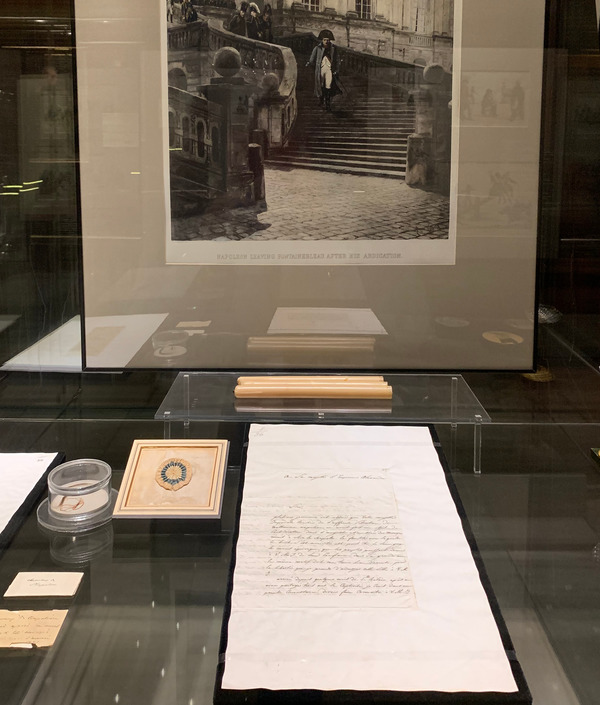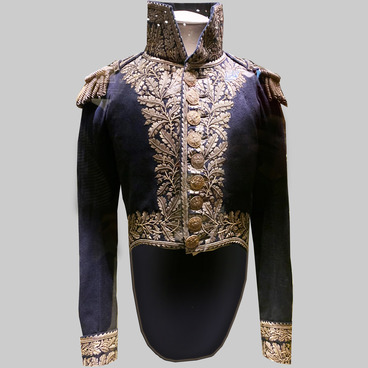On the 31st of March 1814 columns of the allied troops entered Paris to music and the drumbeat. Alexander I on a white horse, which had been presented to him by Napoleon, was marching among the first. The Emperor entered the capital of France accompanied by the King of Prussia, Field Marshal of Austria and an enormous retinue.
While the allies were solemnly going to enter Paris, Napoleon was in his residence in Fontainebleau where the rest of still loyal to him forces were coming in flocks exhausted with the fast march. Exactly here on the 4th of April on marshals' demand after a dramatic exchanging of opinions Napoleon signed the abdication from the throne in favour of his son and in two days-the final abdication from the Imperial Throne of France.
According to the treaty of the 11th of April 1814 signed by Napoleon and the representatives of Russia, Austria and Prussia in Fontainebleau, Napoleon and his wife Marie Louise retained their titles but relinquished power and claims to the crown from their heirs.
In compensation, Napoleon got in a lifelong ownership the Isle of Elba (20 km away from port Piombino between the coast of Italy and Corsica, which had been earlier attached to France by him) and also an allowance of 2 million francs from the government of Louis XVIII.
Russia and its army played a crucial role in the victory over Napoleon. All Europe called Alexander I a ‘liberator’, ‘tsar of all tsars’, and ‘Agamemnon’. According to the opinion of the people close to him, he had an outstanding gift of seduction: ‘he could captivate minds eminently and penetrate into people’s souls ‘.
Russian Emperor and Autocrat brilliantly showed his best traits of character during his stay in France, winning popularity among hundreds of thousands of citizens of Paris. He strictly forbade Russian troops to take revenge upon local population, copying the actions of French in Russia. Alexander I ordered to demonstrate the greatest possible friendliness, winning Parisians with his generosity.
In the museum’s exposition, the portrait gallery of the winners, mostly Russian military commanders and heroes of the campaign of 1812, is represented. Their numerous sculptures, depictions on the engravings and paintings remain.
Memorial things that belonged to Napoleon are represented with a strand of hair, cut after his death by Marshal Bertrand (he followed Bonaparte to the island of St. Helena and was present at his demise), a cockade from the hat, which Emperor was wearing during the Battle of Waterloo- the last crushing defeat from the united forces of European states, and also wax candles from Fontainebleau, which were standing on the table during the signing of the abdication.
While the allies were solemnly going to enter Paris, Napoleon was in his residence in Fontainebleau where the rest of still loyal to him forces were coming in flocks exhausted with the fast march. Exactly here on the 4th of April on marshals' demand after a dramatic exchanging of opinions Napoleon signed the abdication from the throne in favour of his son and in two days-the final abdication from the Imperial Throne of France.
According to the treaty of the 11th of April 1814 signed by Napoleon and the representatives of Russia, Austria and Prussia in Fontainebleau, Napoleon and his wife Marie Louise retained their titles but relinquished power and claims to the crown from their heirs.
In compensation, Napoleon got in a lifelong ownership the Isle of Elba (20 km away from port Piombino between the coast of Italy and Corsica, which had been earlier attached to France by him) and also an allowance of 2 million francs from the government of Louis XVIII.
Russia and its army played a crucial role in the victory over Napoleon. All Europe called Alexander I a ‘liberator’, ‘tsar of all tsars’, and ‘Agamemnon’. According to the opinion of the people close to him, he had an outstanding gift of seduction: ‘he could captivate minds eminently and penetrate into people’s souls ‘.
Russian Emperor and Autocrat brilliantly showed his best traits of character during his stay in France, winning popularity among hundreds of thousands of citizens of Paris. He strictly forbade Russian troops to take revenge upon local population, copying the actions of French in Russia. Alexander I ordered to demonstrate the greatest possible friendliness, winning Parisians with his generosity.
In the museum’s exposition, the portrait gallery of the winners, mostly Russian military commanders and heroes of the campaign of 1812, is represented. Their numerous sculptures, depictions on the engravings and paintings remain.
Memorial things that belonged to Napoleon are represented with a strand of hair, cut after his death by Marshal Bertrand (he followed Bonaparte to the island of St. Helena and was present at his demise), a cockade from the hat, which Emperor was wearing during the Battle of Waterloo- the last crushing defeat from the united forces of European states, and also wax candles from Fontainebleau, which were standing on the table during the signing of the abdication.



